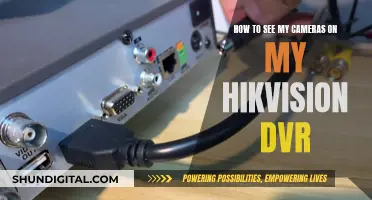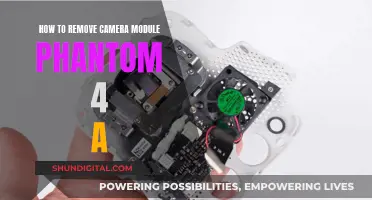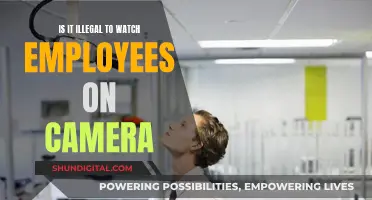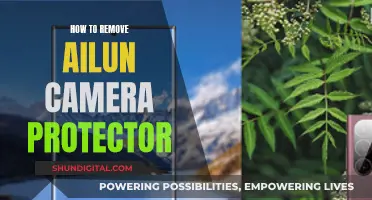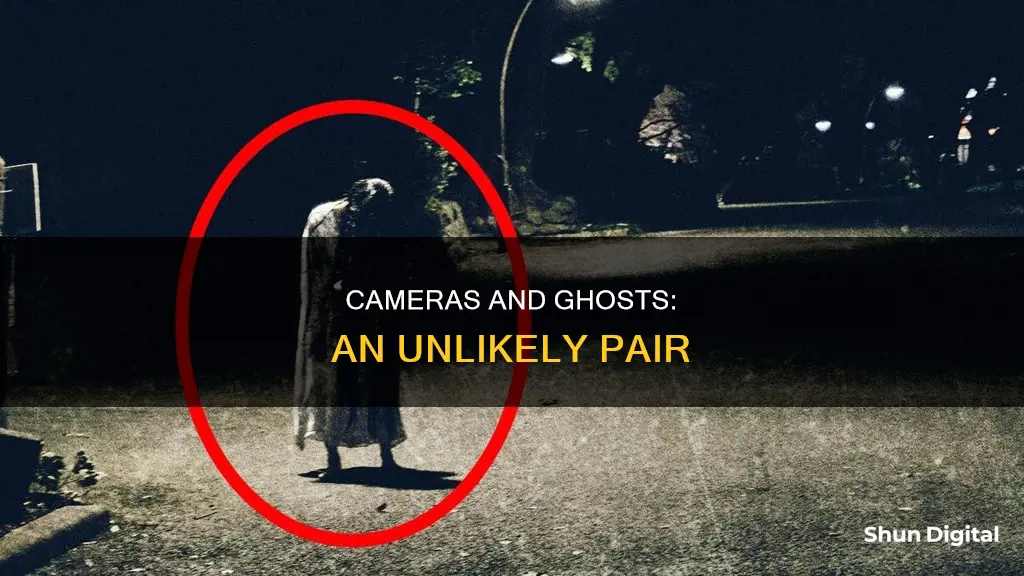
The concept of capturing ghosts on camera has been a topic of fascination for many, with spirit photography dating back to the late 19th century. However, despite advancements in camera technology, the evidence for ghosts remains elusive and limited to ambiguous anomalies recorded with low-quality cameras or good-quality cameras hampered by low-light conditions. This has led to questions about why ghosts, if they exist, elude clear photographic documentation. The answer may lie in a combination of factors, including the limitations of cameras compared to the human eye, the potential for unconscious filtering by the brain, and the impact of lighting and exposure settings.
| Characteristics | Values |
|---|---|
| Photographic evidence of ghosts | Often low-quality, grainy, ambiguous, blurry, or indistinct |
| Ghost hunters' equipment | Sometimes low-quality, sabotaged by low-light conditions |
| Ghost impostors | Random shadows, unnoticed reflections, video artifacts, dust or smoke |
| Cameras | Can pick up things the human eye can't see, e.g. IR cameras and night vision |
| Human eye | Can only pick up certain wavelengths of light |
| Ghost photos | Often show orbs, hazy human shapes, or ectoplasmic mist |
| Ghost cam apps | Allow users to place, rotate, adjust transparency, and erase parts of ghost images |
What You'll Learn

Cameras can't see ghosts because ghosts don't exist
The concept of ghosts and spirits has captivated humans for centuries, with many individuals claiming to have witnessed or captured paranormal activity through photographs or videos. However, the idea that cameras can see ghosts presupposes their existence, which remains unproven and highly controversial. In reality, there are several more plausible explanations for the supposed "ghost sightings" captured by cameras.
Firstly, it is important to acknowledge the limitations of both human vision and camera technology. The human eye, in conjunction with the brain, is incredibly adept at interpreting and making sense of the world around us. However, there are certain phenomena that our eyes cannot perceive, such as certain wavelengths of light or minute details that our brains unconsciously filter out. Cameras, on the other hand, are limited by their physical characteristics, such as shutter speed and light sensitivity, and can be fooled by various factors like lighting conditions, reflections, or camera artifacts.
The belief in ghosts and the desire for evidence of an afterlife have led to the popularity of spirit photography, which dates back to the 19th century. Photographers would employ tricks, such as double exposures, reflections, or camera artifacts, to create images that appeared to depict ghosts or spirits. With the widespread availability of cameras today, anyone can capture ambiguous anomalies that can be interpreted as paranormal activity. However, these anomalies are often the result of low-light conditions, camera straps, dust particles, lens flare, or even digital artifacts created by modern cameras.
Furthermore, the notion that ghosts exist only in the realm of cameras and not in plain sight to the human eye is illogical. If ghosts were real, they would exist independently of our methods of detection. The fact that ghosts have never been reliably captured or observed under controlled scientific conditions strongly suggests that they are not real. While it is true that some people claim to have witnessed ghosts or paranormal activity, these experiences are often subjective and lack empirical evidence.
In conclusion, the idea that cameras can see ghosts is based on the unfounded assumption that ghosts exist in the first place. The "evidence" presented by spirit photography and amateur ghost hunters can be easily explained by natural phenomena, camera limitations, or deliberate hoaxes. Until there is scientific proof of the existence of ghosts, the most reasonable conclusion is that they are a product of human imagination, suggestibility, and our desire to explain the unknown.
The NSA and Your Camera: What You Need to Know
You may want to see also

Cameras can't see ghosts because they exist in another realm
Ghost sightings have been reported for centuries, and with the advent of photography in the 19th century, spirit photography (also called ghost photography) emerged as a way to capture images of ghosts and other supernatural entities. However, the idea that cameras can capture ghosts has been a subject of debate and intrigue, with many believing that ghosts exist in another realm that eludes traditional methods of detection.
The notion that ghosts inhabit a different realm stems from the understanding that they are spiritual entities, existing outside the physical realm that humans typically perceive. This belief is deeply rooted in various cultural and religious traditions, which propose that ghosts are manifestations of souls or spirits that have not passed on to the afterlife. This alternative realm is thought to be beyond the reach of conventional cameras, which are designed to capture physical light and objects.
While many ghost sightings and photographs have been reported over the years, the evidence often relies on ambiguous anomalies captured with low-quality cameras or in conditions with poor lighting. These factors can create artifacts such as lens flare, reflections, or double exposures, which can be misinterpreted as ghostly apparitions. Despite advancements in camera technology, the quality of ghost photographs has not significantly improved, suggesting that these anomalies may not be actual ghostly manifestations.
It is worth noting that some people believe that ghosts may exist in a different light spectrum or wavelength that is beyond the range of human vision and traditional cameras. This belief is supported by the fact that cameras and the human eye have limitations in terms of the wavelengths of light they can detect. However, with the development of specialized cameras, such as IR cameras and night vision, it is now possible to capture images beyond the visible spectrum, yet clear evidence of ghosts remains elusive.
In conclusion, the idea that ghosts exist in another realm that cannot be captured by cameras persists due to the lack of concrete photographic evidence. While advancements in technology have improved our ability to capture images, ghosts, if they exist, may inhabit a realm that is beyond our current methods of detection. The ongoing fascination with capturing ghostly images continues to fuel discussions and investigations into the supernatural realm.
Peloton Camera: See Your Friends While Working Out
You may want to see also

Ghosts are scared of high-definition cameras
It seems that ghosts are scared of high-definition cameras. Despite the ever-increasing quality of cameras, with smartphones now having built-in high-definition cameras, there is still no clear evidence of ghosts. The idea that ghosts would be visible on low-quality, grainy, or blurry images but not on high-definition images is absurd.
The fact that ghost sightings are often ambiguous anomalies recorded with low-quality cameras or in low-light conditions is intriguing. With high-definition cameras providing more image information, it should be easier to identify things that may be mistaken for ghosts, such as random shadows, reflections, or video artifacts. However, despite these technological advancements, the ghost-hunting community has failed to produce clear and convincing evidence of ghosts.
One possible explanation for this lack of evidence is that ghosts are scared of high-definition cameras. Perhaps they are aware of the potential consequences of being captured on camera, such as being exposed as fraudulent or being studied and analyzed by scientists. After all, high-definition images are much harder to dismiss or explain away as paranormal activity. It is as if the ghosts know that appearing on a low-quality camera will make people question and wonder, whereas a high-definition image might reveal the truth behind their existence.
Additionally, the popularity of ghost-hunting shows and the widespread availability of camera technology have not yielded any significant improvements in ghost photography. It is as if the ghosts are aware of the cameras and choose to avoid them or remain invisible to them. This further supports the idea that ghosts are scared of high-definition cameras and are actively avoiding being captured on film.
While some may argue that ghosts exist in a different realm or light spectrum that is invisible to high-definition cameras, this does not explain why they continue to appear on low-quality cameras. The lack of clear evidence and the apparent avoidance of high-definition cameras suggest that ghosts are, indeed, scared of being seen in high definition.
Westinghouse Smart TV: Camera and Microphone Features Explained
You may want to see also

Ghosts are only visible to the human eye
It is intriguing to consider why ghosts, if they exist, are not visible to modern cameras. After all, there are more people actively trying to document paranormal activity than ever before, and thanks to smartphones, high-quality cameras are virtually always within reach. Despite this, the photographic and video evidence for ghosts remains elusive, often taking the form of grainy, ambiguous anomalies.
One possible explanation for this phenomenon is that ghosts are only visible to the human eye. While this may seem counterintuitive, it is worth considering the complexities of human vision and cognition. The human eye, in conjunction with the brain, is capable of interpreting a vast array of visual information, much of which occurs outside of our conscious awareness. The brain filters and processes visual stimuli, allowing us to focus on what is most relevant or salient in a given moment. It is possible that ghosts, or other paranormal entities, exist within this filtered or unseen realm.
Additionally, the human eye is capable of perceiving a limited range of the light spectrum, and there may be visual phenomena that are simply beyond the scope of camera sensors to capture. For example, certain infrared wavelengths may be visible to the human eye in certain conditions, such as the infrared light coming from a TV remote, while remaining invisible to cameras. This suggests that there may be aspects of our visual environment that are more readily perceived by the human eye than by a camera lens.
Furthermore, the act of photography itself involves a degree of interpretation and manipulation. A camera captures light and colour in a way that can be deceiving or misleading, particularly in low-light conditions or when certain camera settings are used. The human eye, on the other hand, is constantly adjusting and adapting to changes in lighting and visual stimuli, allowing us to perceive our environment in a dynamic and fluid way. It is possible that ghosts, if they exist, manifest in a way that is more perceptible to the human eye than to the static and limited perspective of a camera.
While it is challenging to definitively prove or disprove the existence of ghosts, it is intriguing to contemplate the idea that they may exist solely within the realm of human perception. This notion raises fascinating questions about the limitations of technology and the complexities of human vision and cognition.
Concealing Your LG 4K TV Camera: A Step-by-Step Guide
You may want to see also

Ghosts are visible to animals but not to humans or cameras
It is a widely held belief that animals can see ghosts, with numerous anecdotes of pets behaving strangely, seemingly in response to some unseen entity. Dogs, for example, may bark at empty spaces or refuse to enter certain areas of a house. Cats might suddenly stop playing to stare at nothing, or climb onto their owner's lap for comfort. These behaviours are often interpreted as signs that the animal is sensing something beyond human perception.
However, there is no scientific evidence to support supernatural sightings, and such beliefs are largely based on anecdotal reports and personal interpretations. While it is true that animals, such as dogs and cats, possess heightened senses compared to humans, their behaviours can often be explained by factors other than the paranormal. For instance, a dog barking at an empty corner may be responding to a small sound or scent that goes unnoticed by humans. Similarly, a cat's sudden change in behaviour could be due to their highly developed senses of hearing and smell, which allow them to perceive subtle changes in their environment that humans cannot.
Additionally, it is worth noting that the idea of ghosts and spirits is itself a matter of belief and speculation, with no scientific consensus on their existence. While some people firmly assert the presence of ghosts, others remain sceptical, attributing ghostly encounters to suggestibility, cognitive biases, or misinterpretation of sensory information.
Interestingly, the notion that ghosts are visible to animals but not to humans or cameras underscores the enduring fascination with the paranormal and the desire to uncover evidence of a spirit realm. This is reflected in the popularity of ghost-hunting shows and amateur ghost-hunting groups, despite the lack of scientific evidence supporting their claims.
In conclusion, while it is intriguing to speculate that animals can see ghosts, the available evidence is largely anecdotal and open to interpretation. The absence of clear and compelling evidence, especially in an age of widespread access to high-quality cameras, suggests that the idea of ghosts visible to animals but not humans or cameras remains speculative and unverifiable.
DPS and Privacy: Cameras Watching Your Every Move?
You may want to see also
Frequently asked questions
Cameras are unable to see ghosts because ghosts do not exist. Most "evidence" for ghosts is in the form of brief, ambiguous anomalies recorded with low-quality cameras or good-quality cameras sabotaged by low-light conditions.
People think that cameras can see ghosts because of the many photographs that claim to show ghosts. These photographs are often taken with low-quality cameras, in low-light conditions, and can be manipulated or faked.
One famous example is a photograph taken by Sybell Corbet in 1891 of the library at Combermere Abbey in Cheshire, England. The photo showed the faint outline of a man's head, collar, and right arm, believed to be the ghost of Lord Combermere, who had recently died. However, skeptics attributed this image to a long exposure, explaining the ghostly outline as someone, possibly a servant, who walked into the room and paused during the one-hour exposure.
Some people have suggested that cameras can capture paranormal activity that the human eye cannot perceive. Others argue that ghost photographs are the result of natural camera artifacts, such as flash reflecting off dust particles, lens flare, pareidolia, or deceptions using smartphone applications that add ghost images to existing photographs.



